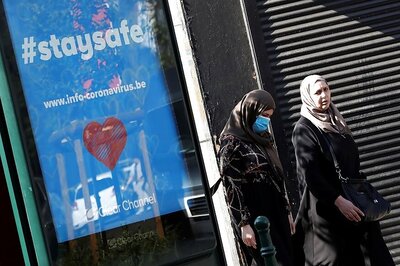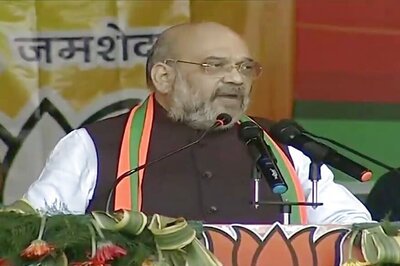
views
The Bodo accord signed on January 27 has created a record of sorts in the annals of insurgency in the country. Never before have separatist rebels inked an agreement with the government in such a brief span after crossing over from a neighbouring country.
The Saoraigwra faction of the National Democratic Front of Boroland, or NDFB (S), was already fighting for survival after raids on the rebel camps at Taga last year in January by the Myanmar military, Tatmadaw. Even as the group drifted in a southern direction after the operation, two Bodo youths – one of them an IIT graduate – acted as intermediaries with the approval of the home ministry to prepare the ground for their return to Assam.
A couple of weeks later, all the NDFB factions including the overground groups joined hands with the All Bodo Students’ Union (ABSU) to sign the agreement in New Delhi considered more exhaustive and wide-ranging than the previous two accords with Bodo groups in 1993 and 2003. But it has also fuelled speculation over the consequences of the hasty pact.
What Triggered the Episode?
The NDFB (S) is fortunate to have landed in Assam at a time when the government is on the back foot and trying to wriggle out of the chaos resulting from the Citizenship (Amendment) Act. Without the agitation, its predicament would have been the same as the other overground militant outfits in the region – staying in designated camps and engaging in talks with the government at regular intervals.
Certainly, the accord was the first major fallout of the protests against the CAA in Assam which has all the ingredients to upset political equations in the state. The Bodoland People’s Front (BPF) and Asom Gana Parishad (AGP) are key partners of the BJP in the coalition government in the state and the two parties had won 26 seats out of the total 87 that the ruling partners bagged in the assembly polls in 2016.
A definitive conclusion that can be arrived at on the impact of the protests against the CAA in Assam is the declining fortune of the AGP which was formed in 1985 with the mandate of identifying and deporting foreign nationals. Incidents in the past two months do not augur well for the party’s future with a faction led by former chief minister Prafulla Kumar Mahanta and senior leader Brindaban Goswami taking positions against party president and agriculture minister Atul Bora and his coterie’s stance in favour of the new citizenship law. On several occasions, functionaries opposed to the new law were barred from holding meetings at the office in Guwahati.
An AGP functionary in Nalbari goes to the extent of claiming that the party would be able to contest the assembly polls for the last time next year. “Thereafter, there will be no trace of AGP. The space will be occupied by the new party to be launched by the All Assam Students’ Union (AASU),” he said. His views are shared by party workers from other districts some of whom also had to face the ire of angry anti-CAA protesters.
Message to BPF’s Rivals
With the AGP’s prospects of repeating the same performance in next year’s assembly polls extremely thin, the BJP has quietly begun a damage-control exercise in the Bodoland Territorial Area Districts (BTAD) where its coalition partner Bodoland People’s Front (BPF) is facing anti-incumbency. In particular, there have been repeated complaints against the ‘dictatorial’ style of functioning of its supremo, Hagrama Mohilary, who is also the chief executive member of the Bodoland Territorial Council. The BPF had won 12 seats in the previous assembly polls in Assam.
If the accord had not been clinched and the NDFB factions not included, there were high chances of the rebels joining hands with Pramod Boro, president of the ABSU, to oust the BPF that has continuously won the council elections since 2005. And, possibly, the Congress would have taken advantage by stitching a pre-poll alliance with Boro ahead of the assembly polls. Reports of the Congress recovering lost ground among the tea tribes in eastern Assam are surfacing, which is also a cause of concern for the BJP.
So, Prime Minister Narendra Modi’s scheduled visit to Kokrajhar on February 7, after cancelling two previous programmes in Guwahati in less than two months, is a well-calculated move to send a message to the factions opposed to Mohilary –the BJP is keen to embrace them as coalition partners in the next government. It may be early to arrive at conclusions but the precedent established in the BTAD by the ruling BPF of supporting any party that secures the largest number of seats in the assembly polls could well be followed by others. The BPF was previously part of the Congress-led coalition government in Assam.
And efforts could also be on by the BJP to repeat the same model in eastern Assam with the new political outfit to be formed by the AASU if a section of party functionaries is to be believed. The BJP would expect the new party to occupy the AGP’s space rather than the Congress as it then keeps the option open for a post- poll alliance.
Non-Bodos Upset with Accord
On the flip side, while the accord will contribute significantly towards ending militancy in the BTAD, the likelihood of continuing unrest and agitations cannot be ruled out. Several non-Bodo leaders are antagonised as they were never consulted by the government ahead of the agreement.
Non-Bodo communities that constitute an overwhelming majority in the four districts of the BTAD have alleged discrimination by the Bodo leadership since the council was formed in 2003. Only 10 are reserved for them out of a total 40 elected seats in the council which will now be increased to sixty. Last year, many organisations held protests following the council’s announcement that no person can sell land in the BTC area to a non-tribal person without prior approval.
The map of the BTAD is all set to change as the accord provides for inclusion of villages contiguous to the BTR with a majority tribal population and exclusion of villages with a majority of non-tribal population currently under the council’s jurisdiction which abut non-Sixth Schedule areas. This clause means that some parts from the neighbouring Bongaigaon, Darrang and Sonitpur districts could be included in the future BTR while areas under the council contiguous to Nalbari, Chirang, Bajali and Barpeta could be excluded. But that would still leave a sizeable chunk of non-Bodos within the council’s jurisdiction who have settled in the interior areas (like the non-Bodo residents of and near Mushalpur in Baksa).
Another clause that could fuel turmoil in the twin hill districts of Dima Hasao and Karbi Anglong which are also under the Sixth Schedule of the Constitution is inclusion of Bodo-Kacharis there in the list of Scheduled Tribes (Hills). Karbi Anglong had already witnessed agitations when this provision was mentioned in the agreement between the government and Bodoland Liberation Tigers (BLT) in 2003. But then, as a government official said, “Not all clauses in the agreement are meant to be implemented immediately.”
Nonetheless, no other council under the Sixth Schedule in the Northeast has been conferred such wide-ranging powers as the BTC. The agreement lists another eight subjects to be transferred from the state government which will take the total to forty-eight to be administered by the council. But this could also trigger demands from the other councils in the region for similar packages and transfer of subjects. Apparently, most of them have consistently complained about erratic disbursal of funds and neglect by the state governments.
(Rajeev Bhattacharyya is a senior journalist in Guwahati. Views expressed are personal.)
















Comments
0 comment